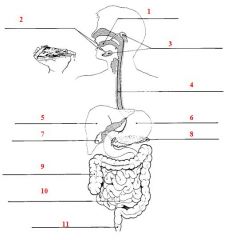![]()
![]()
![]()
Use LEFT and RIGHT arrow keys to navigate between flashcards;
Use UP and DOWN arrow keys to flip the card;
H to show hint;
A reads text to speech;
10 Cards in this Set
- Front
- Back
|
Living Things Use ATP to... (6 functions)
|
1: Maintain homeostatic balance
2: Detect and respond (nervous) to stimuli 3: Reproduce (sexual and asexual reproduction) 4: Synthesise tissue 5: Contract muscles (movement) 6: Prime catabolic pathways |
|
|
3 Types of Carbohydrates (give examples of each)
|
Monosaccharides (sugars) - e.g. glucose
Disaccharides (complex sugars) - e.g. sucrose Polysaccharides (starches and fibres) - e.g. amylose |
|
|
Draw and Describe a Diagram of Villi and Micro-villi
|

Villi massively increase the surface area of the small intestine. The lacteal specifically absorbs lipids.
|
|
|
Draw a Diagram of the Circulatory System
|

|
|

Label the Diagram of the Digestive System
|

|
|
|
Draw a Diagram of the Kidney
|

|
|
|
Draw the Structure of the Nephron
|

|
|
|
Draw a Diagram of the Respiratory System
|

|
|
|
Draw a Diagram of Alveoli
|

|
|
|
Homeostasis
|
The maintenance of a constant internal environment mediated by negative feedback systems
|

